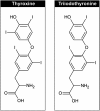Biomarkers of nutrition for development--iodine review
- PMID: 24966410
- PMCID: PMC4093988
- DOI: 10.3945/jn.113.181974
Biomarkers of nutrition for development--iodine review
Abstract
The objective of the Biomarkers of Nutrition for Development (BOND) project is to provide state-of-the-art information and service with regard to selection, use, and interpretation of biomarkers of nutrient exposure, status, function, and effect. Specifically, the BOND project seeks to develop consensus on accurate assessment methodologies that are applicable to researchers (laboratory/clinical/surveillance), clinicians, programmers, and policy makers (data consumers). The BOND project is also intended to develop targeted research agendas to support the discovery and development of biomarkers through improved understanding of nutrient biology within relevant biologic systems. In phase I of the BOND project, 6 nutrients (iodine, vitamin A, iron, zinc, folate, and vitamin B-12) were selected for their high public health importance because they typify the challenges faced by users in the selection, use, and interpretation of biomarkers. For each nutrient, an expert panel was constituted and charged with the development of a comprehensive review covering the respective nutrient's biology, existing biomarkers, and specific issues of use with particular reference to the needs of the individual user groups. In addition to the publication of these reviews, materials from each will be extracted to support the BOND interactive Web site (http://www.nichd.nih.gov/global_nutrition/programs/bond/pages/index.aspx). This review represents the first in the series of reviews and covers all relevant aspects of iodine biology and biomarkers. The article is organized to provide the reader with a full appreciation of iodine's background history as a public health issue, its biology, and an overview of available biomarkers and specific considerations for the use and interpretation of iodine biomarkers across a range of clinical and population-based uses. The review also includes a detailed research agenda to address priority gaps in our understanding of iodine biology and assessment.
© 2014 American Society for Nutrition.
Conflict of interest statement
Author disclosures: F. Rohner, M. Zimmermann, P. Jooste, C. Pandav, K. Caldwell, R. Raghavan, and D. J. Raiten, no conflicts of interest.
Figures




References
-
- Zimmermann MB. Symposium on 'Geographical and geological influences on nutrition’: iodine deficiency in industrialised countries. Proc Nutr Soc 2010;69:133–43. - PubMed
-
- Hetzel BS, Dunn JT. The iodine deficiency disorders: their nature and prevention. Annu Rev Nutr 1989;9:21–38. - PubMed
-
- Haldimann M, Alt A, Blanc A, Blondeau K. Iodine content of food groups. J Food Compos Anal 2005;18:461–71.
-
- Pennington JAT, Schoen SA, Salmon GD, Young B, Johnson RD, Marts RW. Composition of core foods in the U.S. food supply. J Food Compos Anal 1995;8:171–217.
-
- Johner SA, Gunther AL, Remer T. Current trends of 24-h urinary iodine excretion in German schoolchildren and the importance of iodised salt in processed foods. Br J Nutr 2011;106:1749–56. - PubMed
Publication types
MeSH terms
Substances
LinkOut - more resources
Full Text Sources
Other Literature Sources
Medical

